Study on the Evolution Behavior of Humidity Fields in Cement Concrete Pavements of a Coastal Airport During Early Stages in Humid and Hot Areas
Abstract
:1. Introduction
2. Field Simulation Program 3D Humidity
2.1. Calculation Theory of 3D Humidity Field
2.1.1. Field Calculation Model of 3D Humidity
- (1)
- Humidity diffusion model
- (2)
- Temperature correction model
- (3)
- Self-drying model
2.1.2. The Determining Solution Conditions of 3D Humidity Diffusion Differential Equation
- (1)
- Initial moment
- (2)
- Surface boundary conditions
- (3)
- Lower surface boundary conditions
2.1.3. Diffusion Difference Derivation of 3D Humidity Field
2.2. Division of 3D Mesh
3. Early Stage Behavior of Pavement Environmental Field in Humid and Hot Areas
3.1. Working Condition Design
3.2. Distribution of 3D Humidity Field Properties of Concrete Pavement Slabs at Early Stage
3.3. Discussion and Analysis
4. Effect of Different Factors on the Humidity Field of Concrete Pavement Slabs at an Early Stage
4.1. Effect of Environmental Parameters
4.1.1. Effect of Environmental Humidity
4.1.2. Effect of Windspeed
4.1.3. Effects of Solar Radiation
4.2. Effect of Material Parameters
4.2.1. Effect of Cement Type
4.2.2. Effect of Water–Cement Ratio
4.3. Effect of Structure and Construction Parameters
4.3.1. Effect of Thickness of the Pavement Slab
4.3.2. Effect of Paving Time
4.3.3. Effect of Maintenance Methods
5. Parameter Sensitivity Analysis
6. Conclusions
Author Contributions
Funding
Institutional Review Board Statement
Informed Consent Statement
Data Availability Statement
Conflicts of Interest
References
- Liu, K.; Zhang, X.; Wang, Y.; Han, S.; Luo, Z.; Hao, J.; Zhang, J. Laboratory investigation on early-age shrinkage cracking behavior of partially continuous reinforced concrete pavement. Constr. Build. Mater. 2023, 377, 131125. [Google Scholar] [CrossRef]
- Zhang, L.; Huang, J.; Li, P. Prediction of Temperature Distribution for Previous Cement Concrete Pavement with Asphalt Overlay. Appl. Sci. 2020, 10, 3697. [Google Scholar] [CrossRef]
- Berenji Shokatabad, M.; Sarkar, A. Temperature curling and gradient of roller-compacted concrete composite pavements. Constr. Build. Mater. 2022, 353, 129008. [Google Scholar] [CrossRef]
- Rouzmehr, F.; Choi, P.; Nam, J.H.; Won, M. Improvements of quality assurance testing program for subgrade and base layer construction. Constr. Build. Mater. 2021, 310, 125157. [Google Scholar] [CrossRef]
- Cui, T.; Zhang, T.; Wang, J.; Chen, J.; Wang, W.; Wang, H.; Wang, H.; Yang, D. Optimization and regulation of pavement concrete properties in plateau environment with large daily temperature difference: From mixture design to field application. Constr. Build. Mater. 2023, 378, 131167. [Google Scholar] [CrossRef]
- Donnelly, C.A.; Sen, S.; Vandenbossche, J.M. Reduction of critical positive temperature gradients in jointed plain concrete pavements. Int. Pavement Eng. 2023, 24, 2197645. [Google Scholar] [CrossRef]
- Assogba, O.C.; Tan, Y.; Zhou, X.; Zhang, C.; Anato, J.N. Numerical investigation of the mechanical response of semi-rigid base asphalt pavement under traffic load and nonlinear temperature gradient effect. Constr. Build. Mater. 2020, 235, 117406. [Google Scholar] [CrossRef]
- Hu, C.; Sun, Z.; Wang, L. Experimental study on the early-age stress behavior of cement concrete pavement. Eng. Mech. 2021, 138, 163–174. [Google Scholar] [CrossRef]
- Li, Z.; Zhang, Y.; Fa, C.; Zou, X.; Xie, H.; Chen, H.; He, R. Investigation on the Temperature Distribution of Asphalt Overlay on the Existing Cement Concrete Pavement in Hot-Humid Climate in Southern China. Adv. Civ. Eng. 2021, 2021, 2984650. [Google Scholar] [CrossRef]
- Li, X.; Shen, A. Internal Stress Simulation of Pavement Concrete under Coupling Action of Temperature and Humidity. Jianzhu Cailiao Xuebao J. Build. Mater. 2018, 21, 78–84. [Google Scholar] [CrossRef]
- Xing, X.; Zhu, Y.; Xu, W.; Peng, W.; Yuan, Z. Measuring Subsidence Over Soft Clay Highways Using a Novel Time-Series InSAR Deformation Model with an Emphasis on Rheological Properties and Environmental Factors (NREM). IEEE Trans. Geosci. Remote Sens. 2022, 60, 3154430. [Google Scholar] [CrossRef]
- Wei, Y.; Gao, X.; Wang, F.; Zhong, Y. Nonlinear strain distribution in a field-instrumented concrete pavement slab in response to environmental effects. Road Mater. Pavement 2019, 20, 367–380. [Google Scholar] [CrossRef]
- Zhang, B.; Zhang, X.; Zhong, Y.; Li, X.; Hao, M.; Liu, J. Dynamic Inversion Analysis of Structural Layer Modulus of Semirigid Base Pavement considering the Influence of Temperature and Humidity. Adv. Civ. Eng. 2020, 2020, 8899888. [Google Scholar] [CrossRef]
- Ziari, H.; Fazaeli, H.; Olyaei, S.J.V.K.; Ziari, M.A. Evaluation of Effects of Temperature, Relative Humidity, and Wind Speed on Practical Characteristics of Plastic Shrinkage Cracking Distress in Concrete Pavement Using a Digital Monitoring Approach. Int. J. Pavement Res. Technol. 2022, 15, 138–158. [Google Scholar] [CrossRef]
- Mousa, M.R.; Hassan, M.; Carlson, P.; Davis, J.; Mousa, S.R. Development of Cost-Effective Restriping Strategies using Standard Width and Wide Waterborne Paints on Asphalt Pavements in Hot and Humid Climates. Transport. Res. Rec. 2021, 2675, 284–295. [Google Scholar] [CrossRef]
- Liang, S.; Wei, Y. Modelling of creep effect on moisture warping and stress developments in concrete pavement slabs. Int. J. Pavement Eng. 2018, 19, 429–438. [Google Scholar] [CrossRef]
- Peng, J.; Zhang, J.; Li, J.; Yao, Y.; Zhang, A. Modeling humidity and stress-dependent subgrade soils in flexible pavements. Comput. Geotech. 2020, 120, 103413. [Google Scholar] [CrossRef]
- Tamrakar, P.; Nazarian, S. Moisture effects on moduli of pavement bases. Int. J. Pavement Eng. 2021, 22, 1410–1422. [Google Scholar] [CrossRef]
- Mateos, A.; Harvey, J.; Feldman, D.R. Evaluation of the Moisture Dependence of Concrete Coefficient of Thermal Expansion and Its Impacts on Thermal Deformations and Stresses of Concrete Pavements. Transport. Res. Rec. 2020, 2674, 545–555. [Google Scholar] [CrossRef]
- Lyu, Z.; Guo, Y.; Chen, Z.; Shen, A.; Qin, X.; Yang, J.; Zhao, M.; Wang, Z. Research on shrinkage development and fracture properties of internal curing pavement concrete based on humidity compensation. Constr. Build. Mater. 2019, 203, 417–431. [Google Scholar] [CrossRef]
- Vandenbossche, J.M.; Asbahan, R.E. Effects of Temperature and Moisture Gradients on Slab Deformation for Jointed Plain Concrete Pavements. J. Transp. Eng. 2011, 137, 563–570. [Google Scholar] [CrossRef]
- Wei, Y.; Liang, S.; Gao, X. Numerical Evaluation of Moisture Warping and Stress in Concrete Pavement Slabs with Different Water-to-Cement Ratio and Thickness. J. Eng. Mech. 2017, 2, 0001180. [Google Scholar] [CrossRef]
- Yeon, J.-H. Implications of zero-stress temperature for the long-term behavior and performance of continuously reinforced concrete pavement. Constr. Build. Mater. 2015, 91, 94–101. [Google Scholar] [CrossRef]
- Bažant, Z.P.; Najjar, L.J. Drying of concrete as a nonlinear diffusion problem. Cem. Concr. Res. 1971, 1, 461–473. [Google Scholar] [CrossRef]
- Huang, T.; Luo, R. Dependency of Relative Humidity and Temperature on Diffusion Parameters for Water Vapor Diffusing into Asphalt Mixtures. J. Mater. Civ. Eng. 2021, 33, 0003973. [Google Scholar] [CrossRef]
- Poblete, M.; Garcia, A.; David, J.; Ceza, P.; Espinosa, R. Moisture effects on the behavior of PCC pavements. In Proceedings of the 2nd International Workshop on the Theoretical Design of Concrete Pavements, Siquenza, Spain, 4–5 October 1990. [Google Scholar]
- Xi, Y.; Bažant, Z.P.; Jennings, H.M. Moisture diffusion in cementitious materials Adsorption isotherms. Adv. Cem. Based Mater. 1994, 1, 248–257. [Google Scholar] [CrossRef]
- Nasir, M.; Baghabra Al-Amoudi, O.S.; Maslehuddin, M. Effect of placement temperature and curing method on plastic shrinkage of plain and pozzolanic cement concretes under hot weather. Constr. Build. Mater. 2017, 152, 943–953. [Google Scholar] [CrossRef]
- Umar Khan, M.; Nasir, M.; Baghabra Al-Amoudi, O.S.; Maslehuddin, M. Influence of in-situ casting temperature and curing regime on the properties of blended cement concretes under hot climatic conditions. Constr. Build. Mater. 2021, 272, 121865. [Google Scholar] [CrossRef]
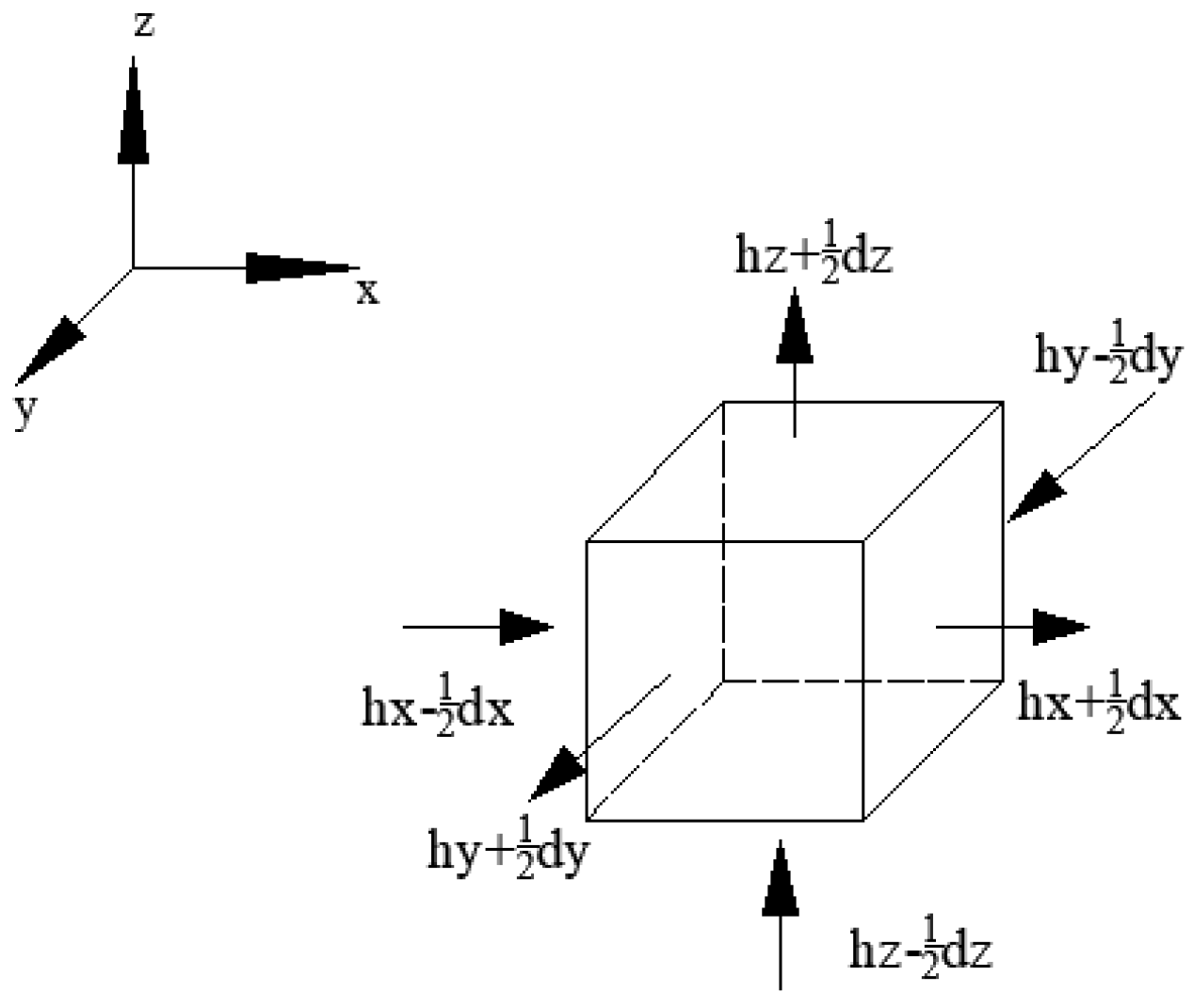
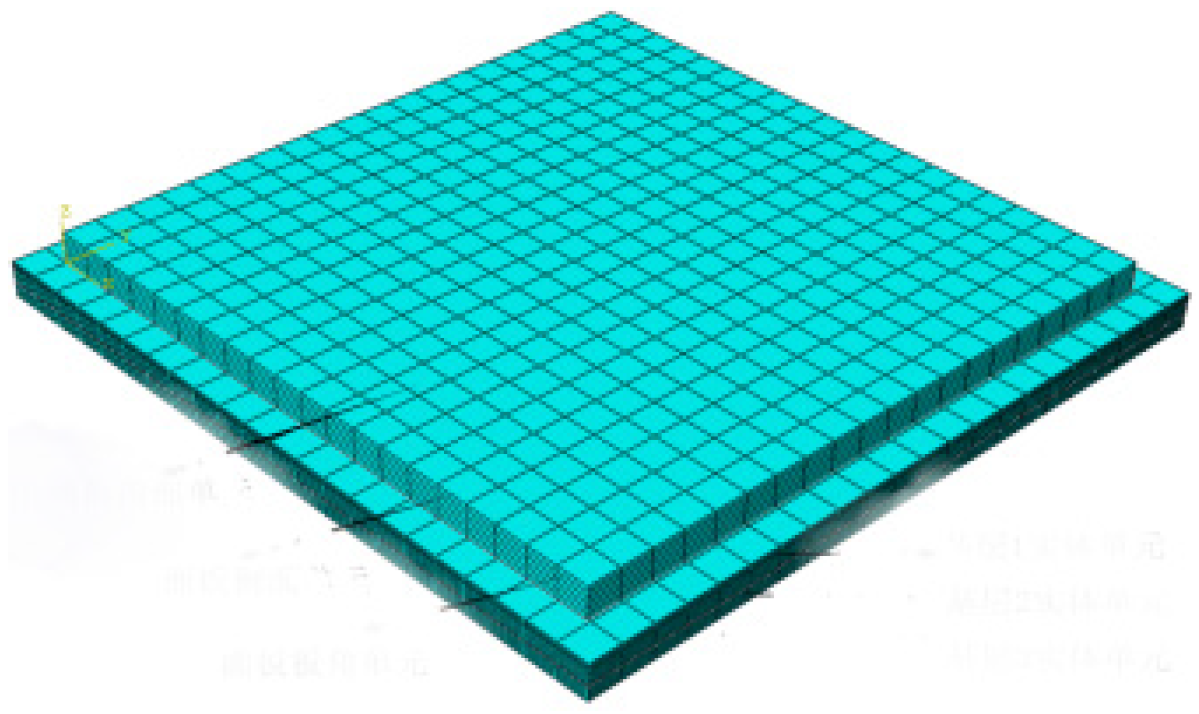


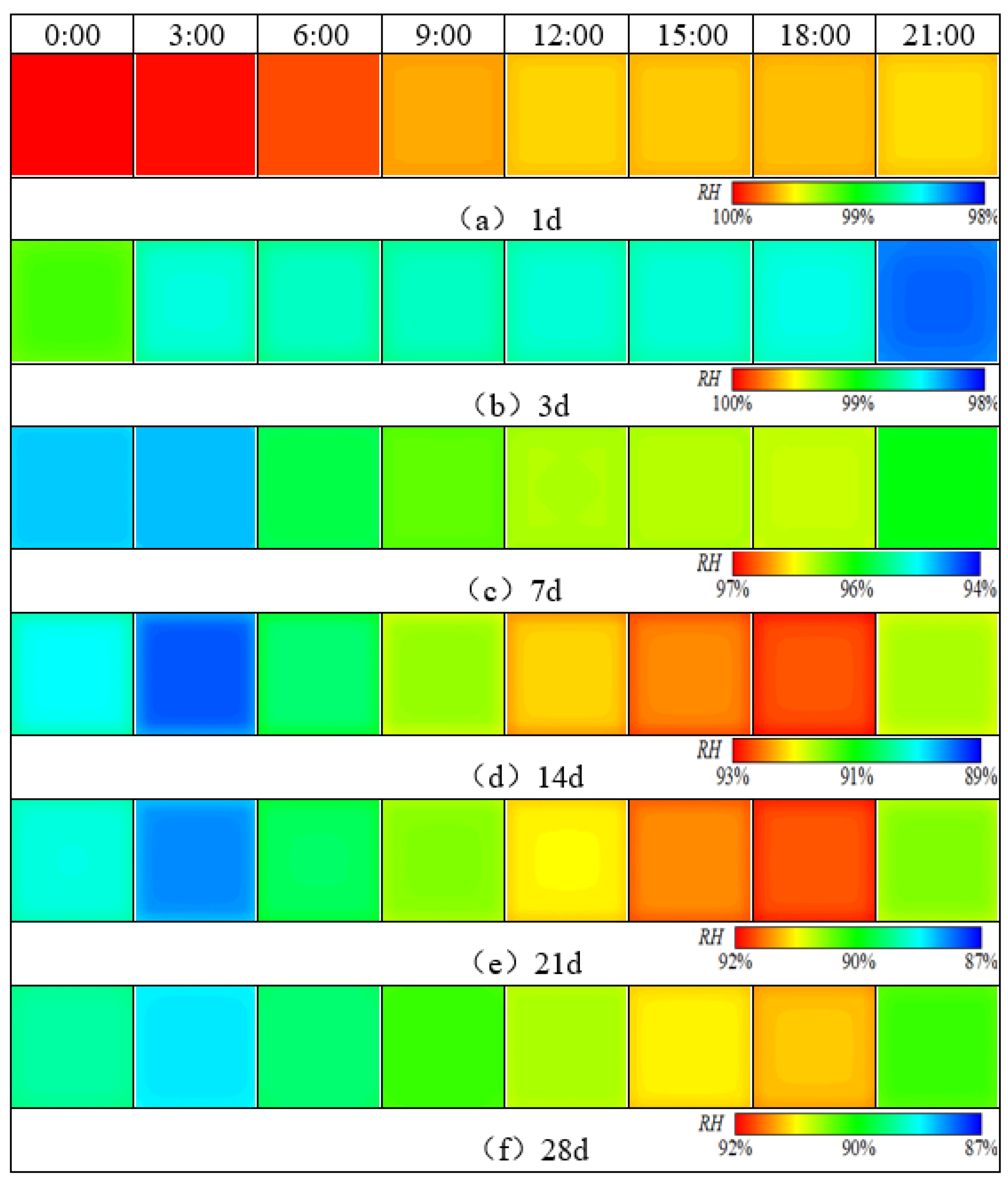
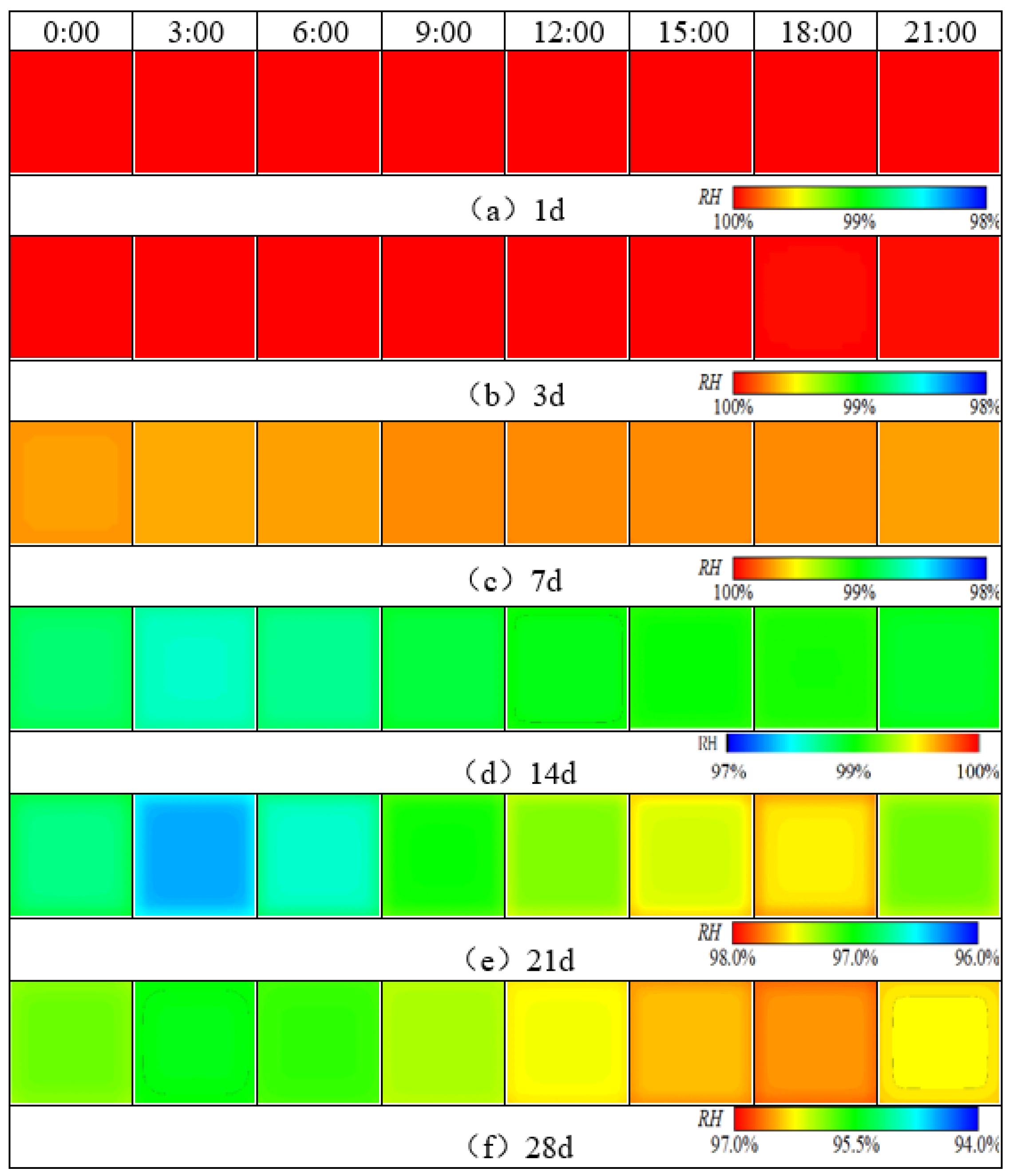

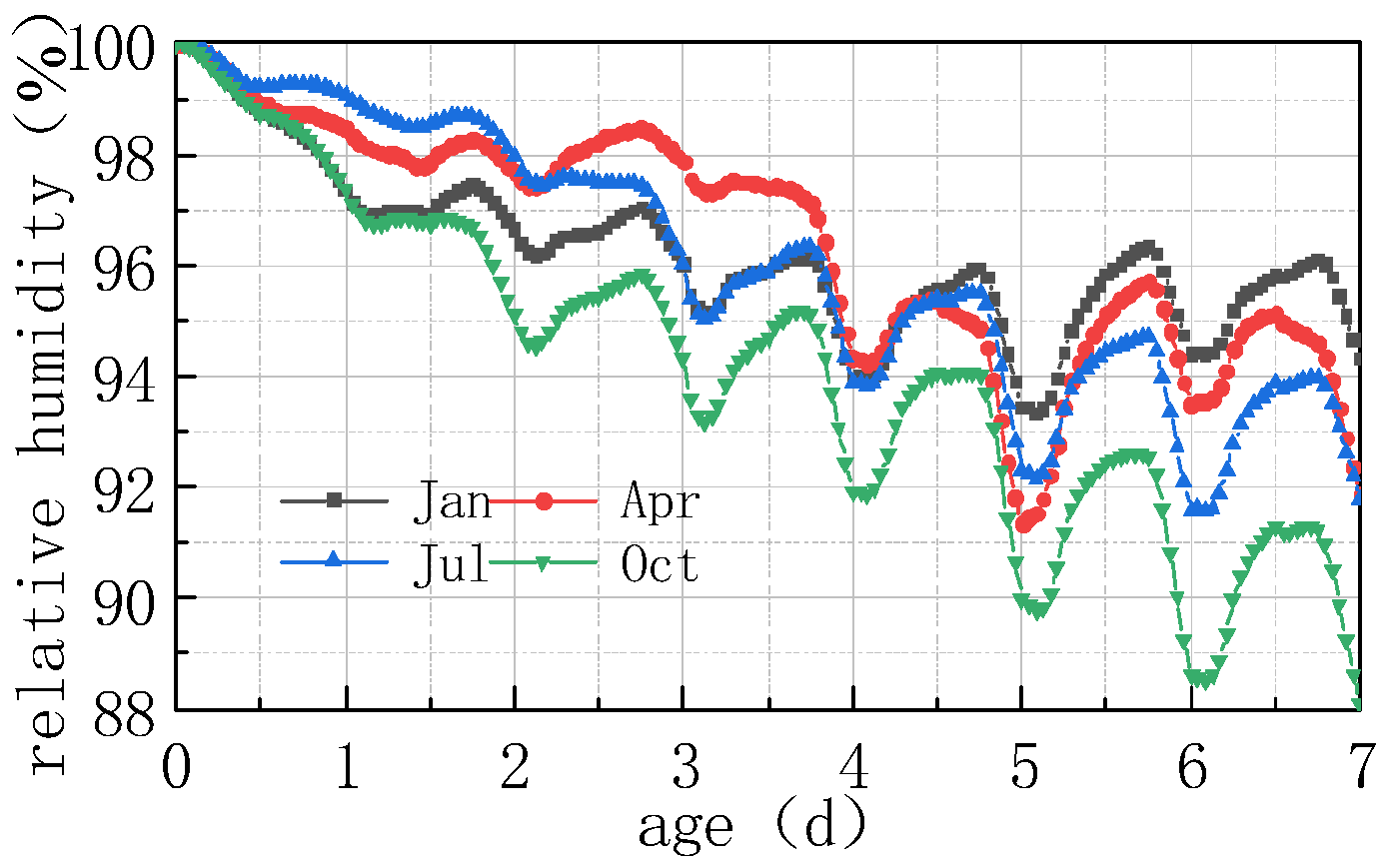
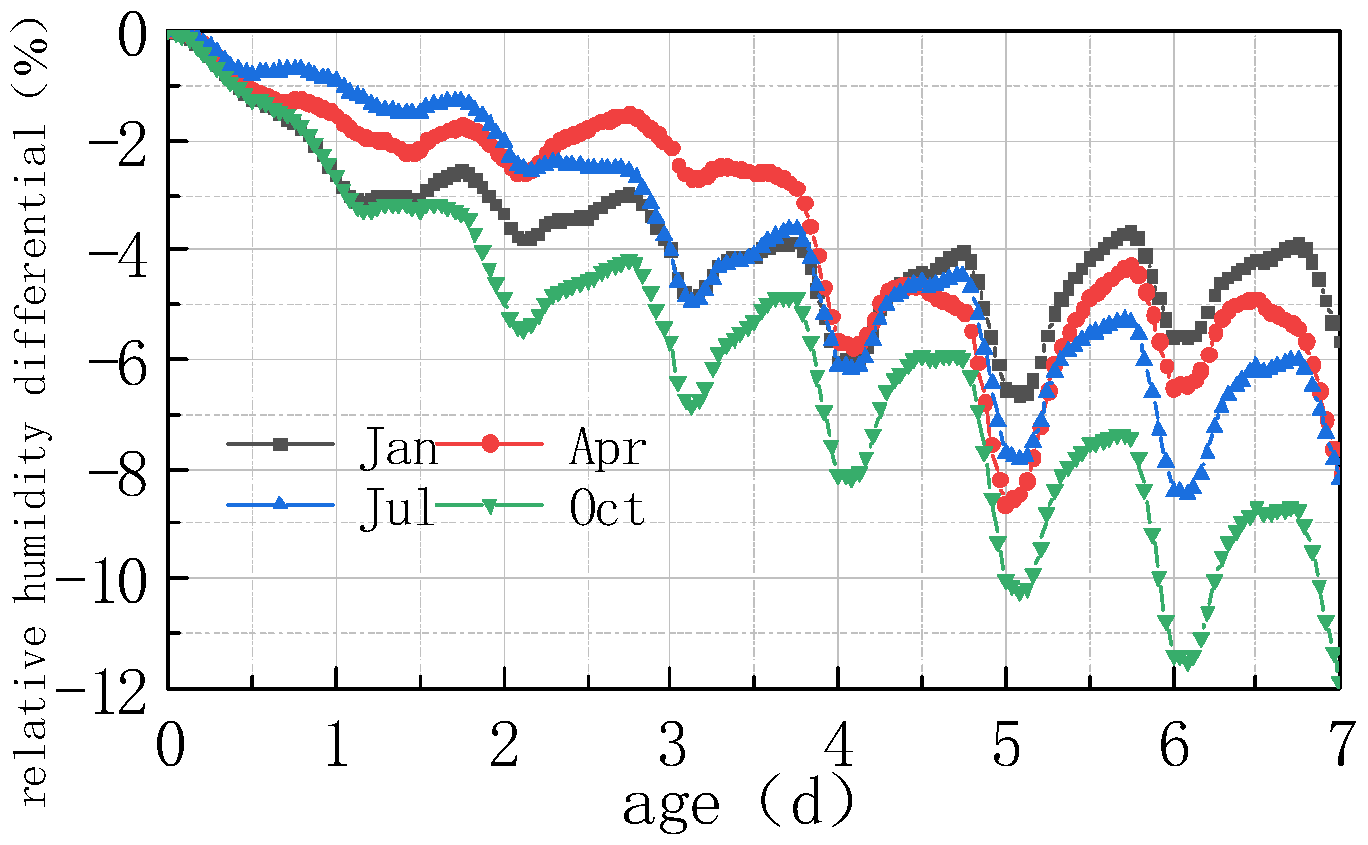
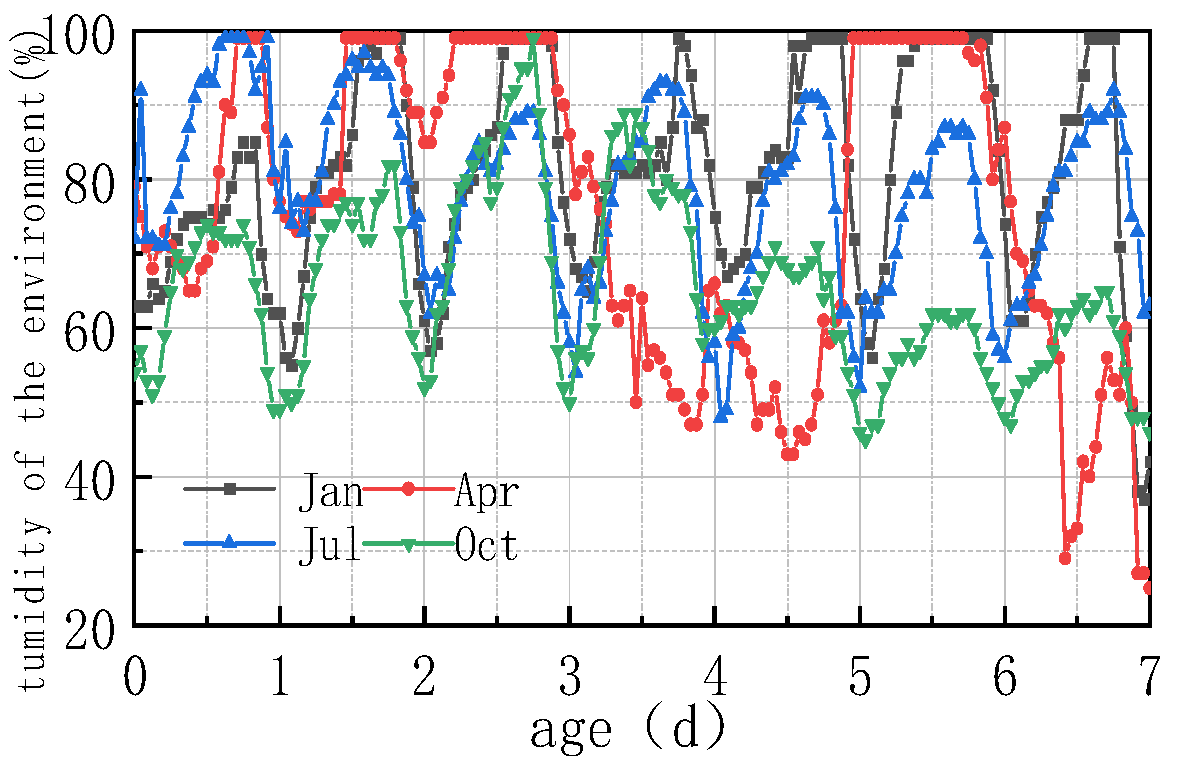
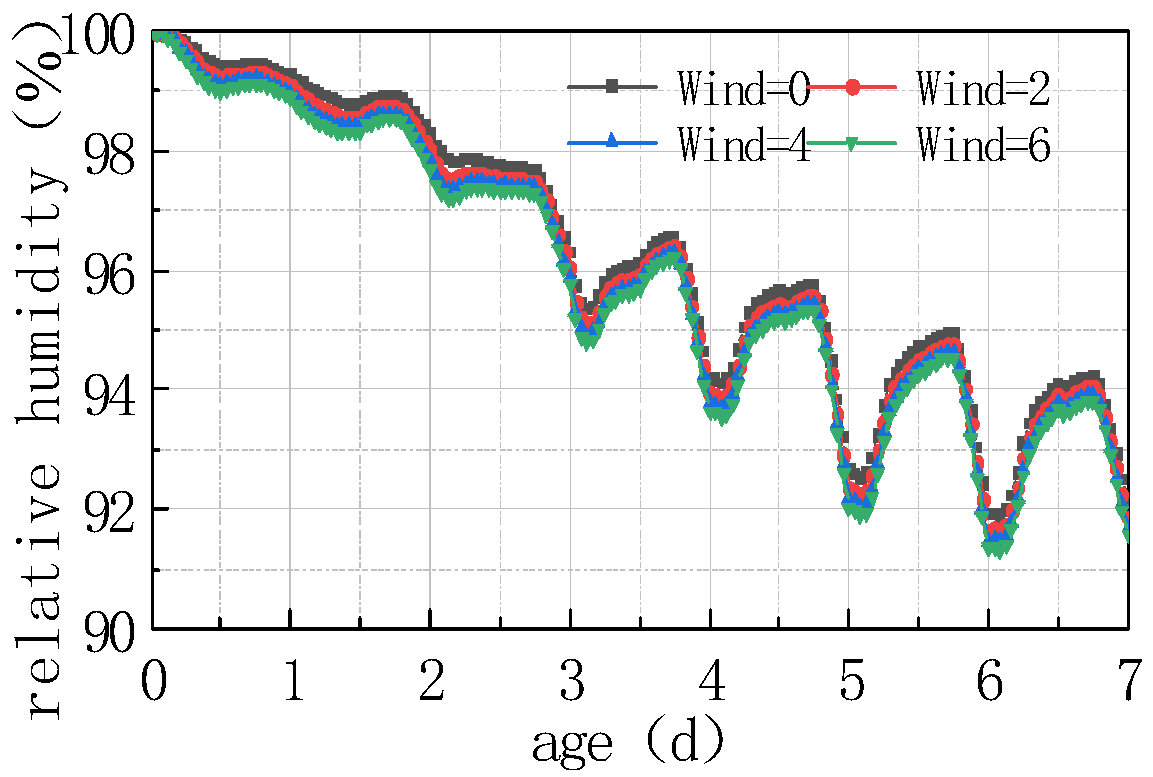

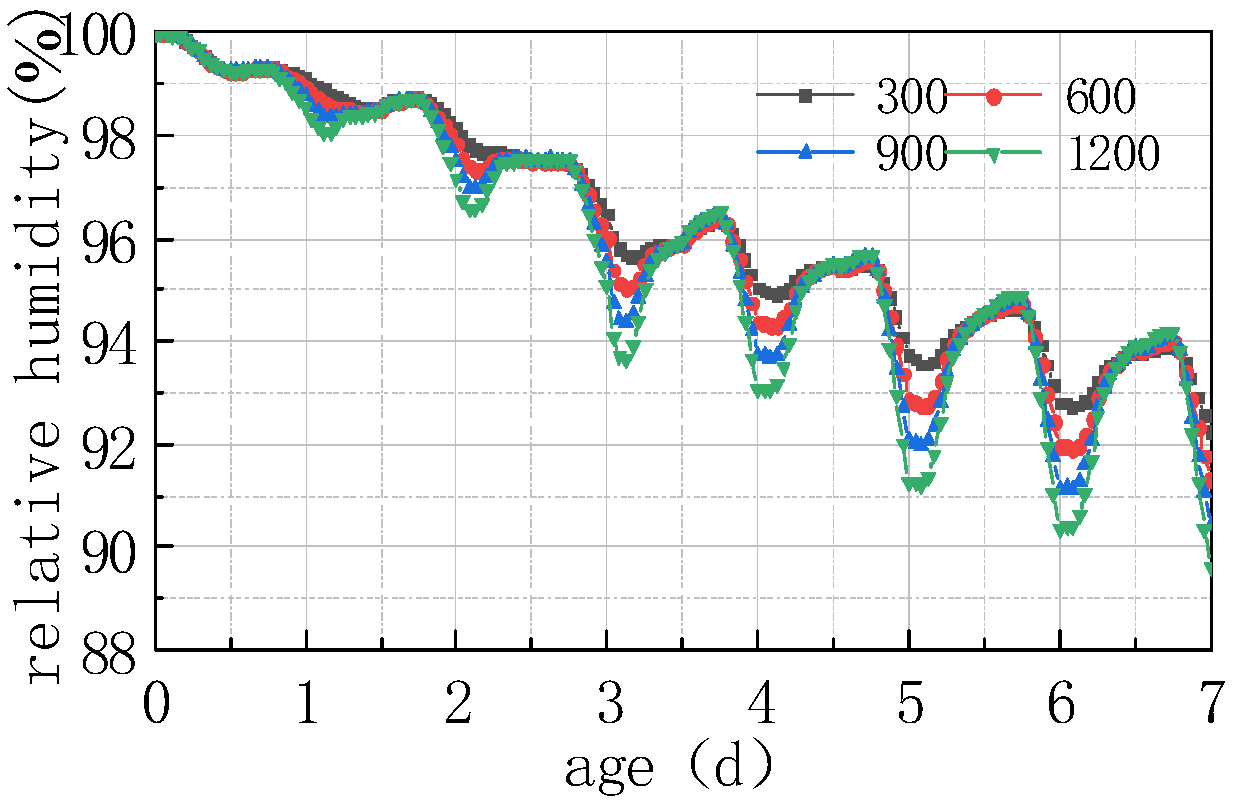
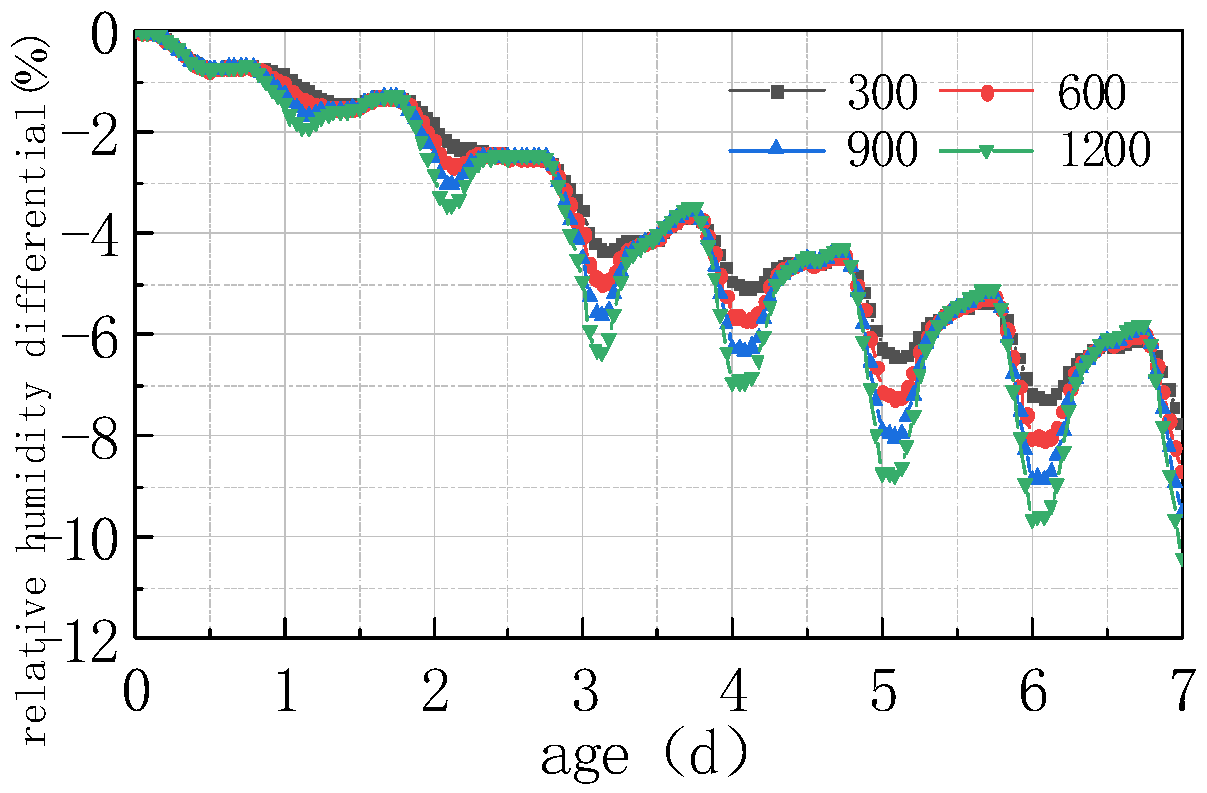
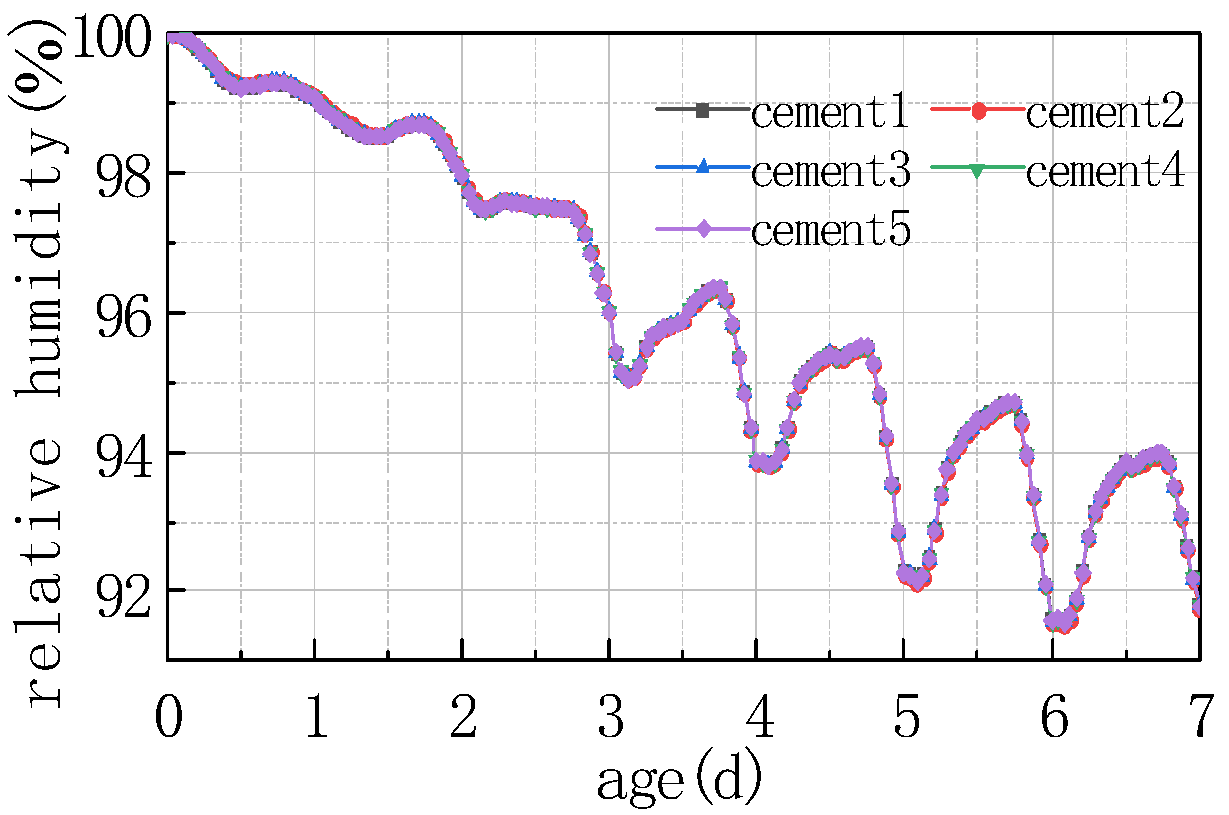
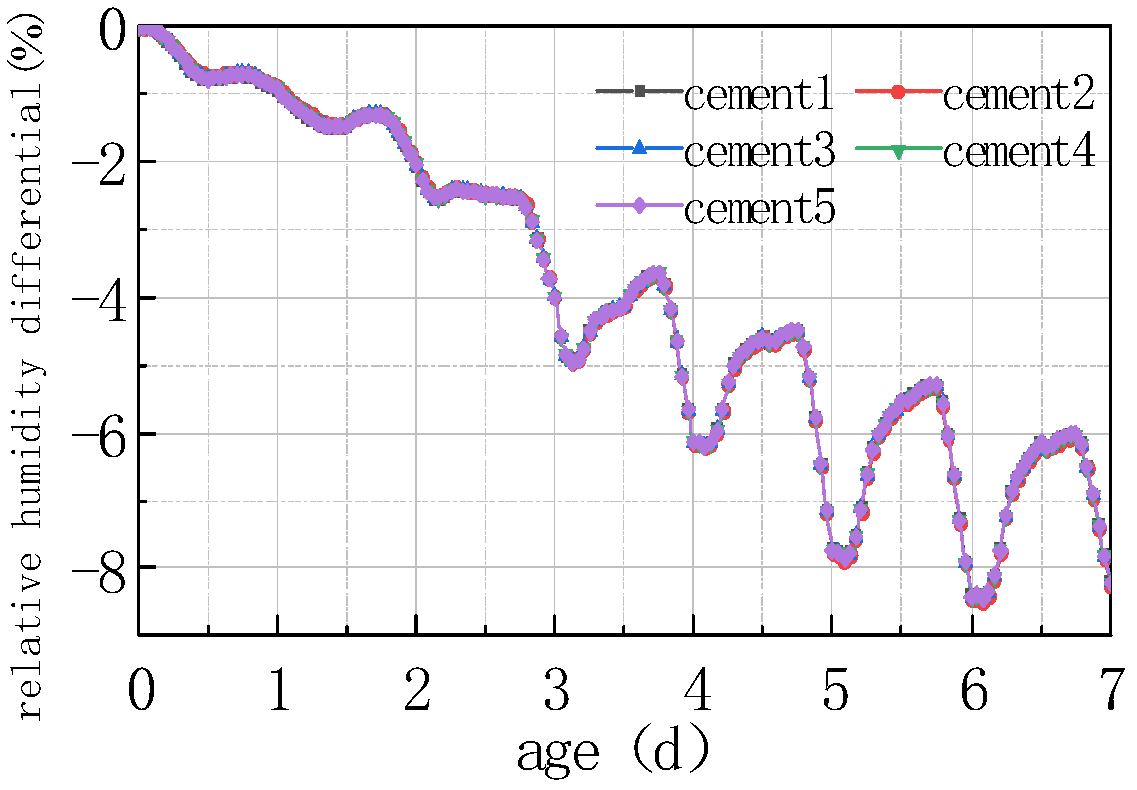
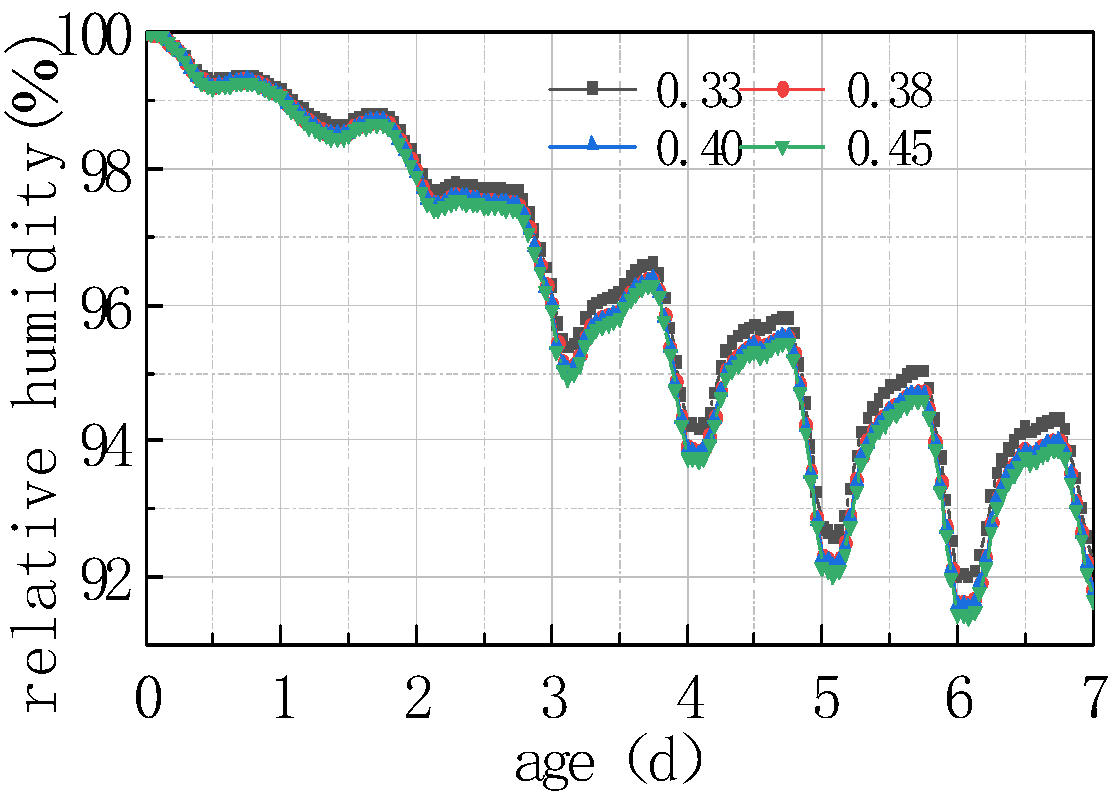
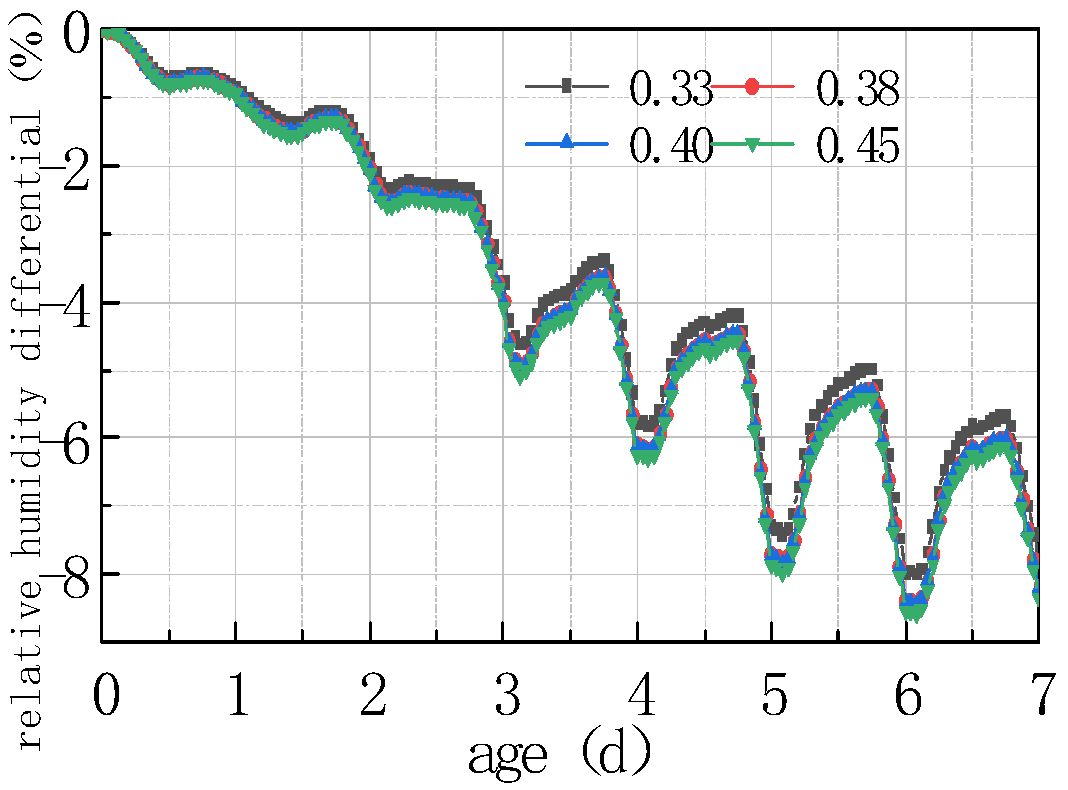
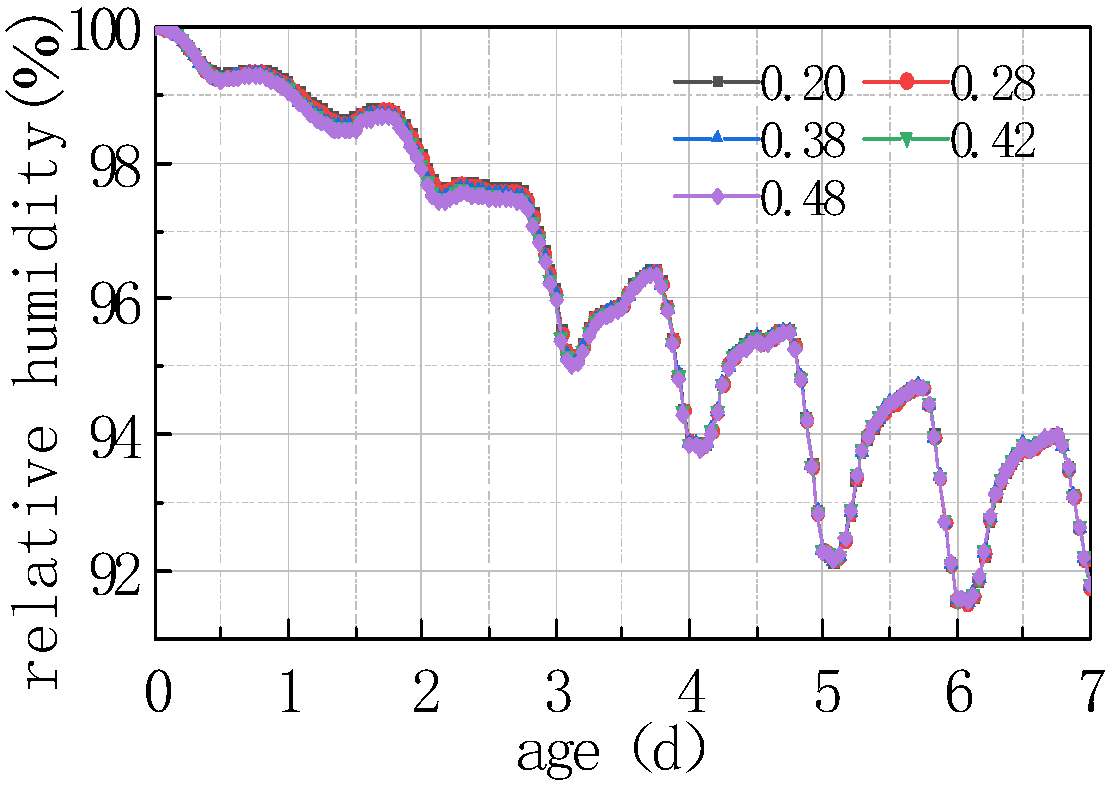
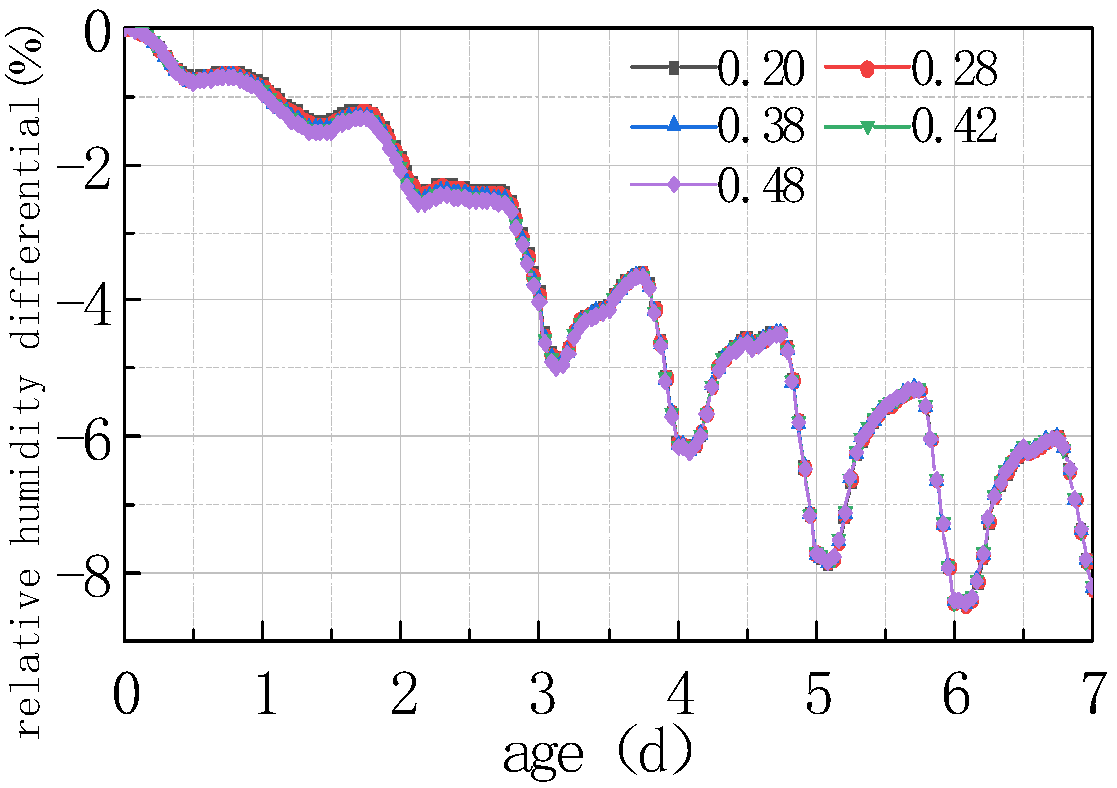
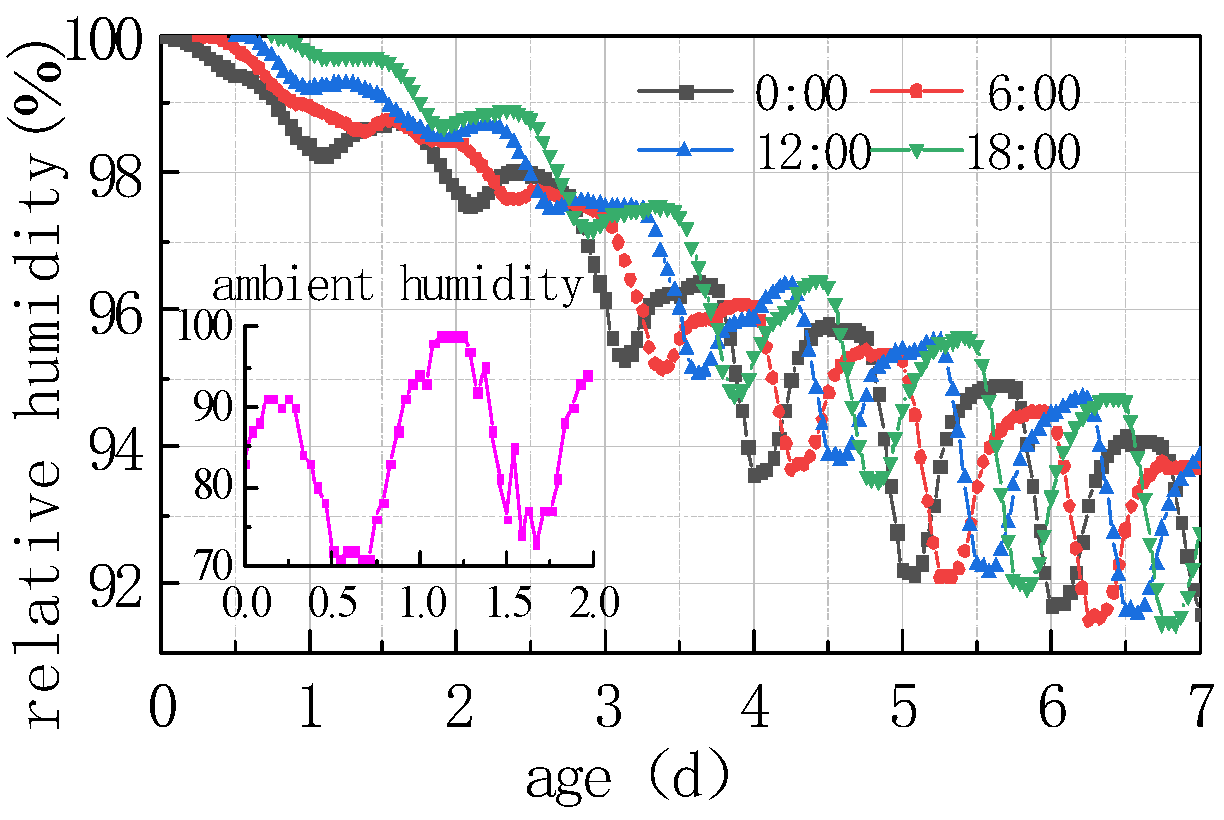
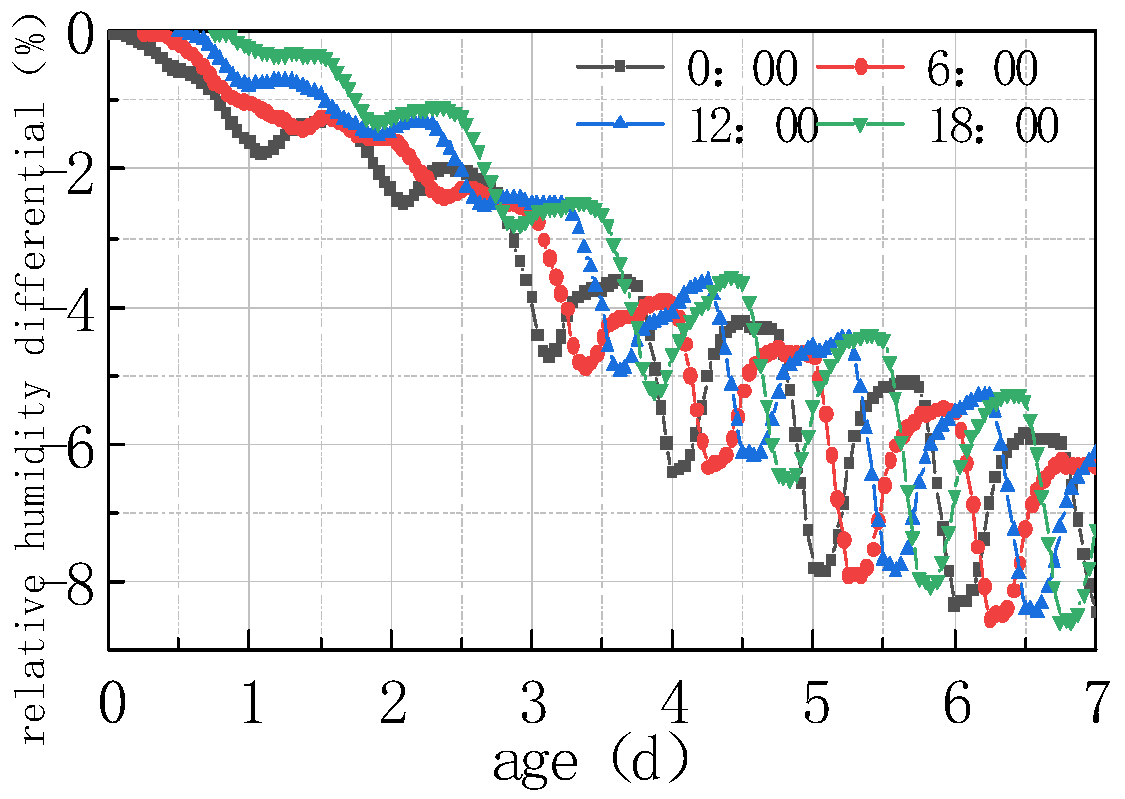
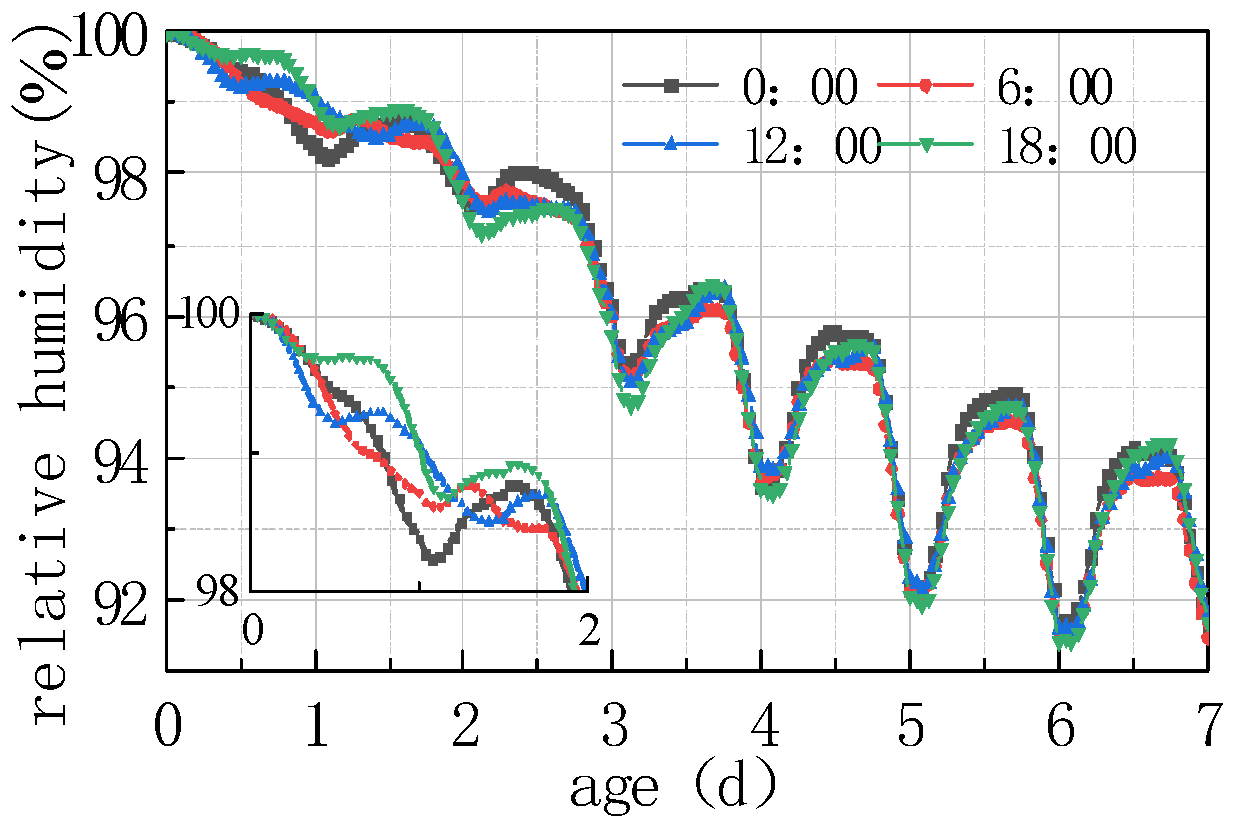

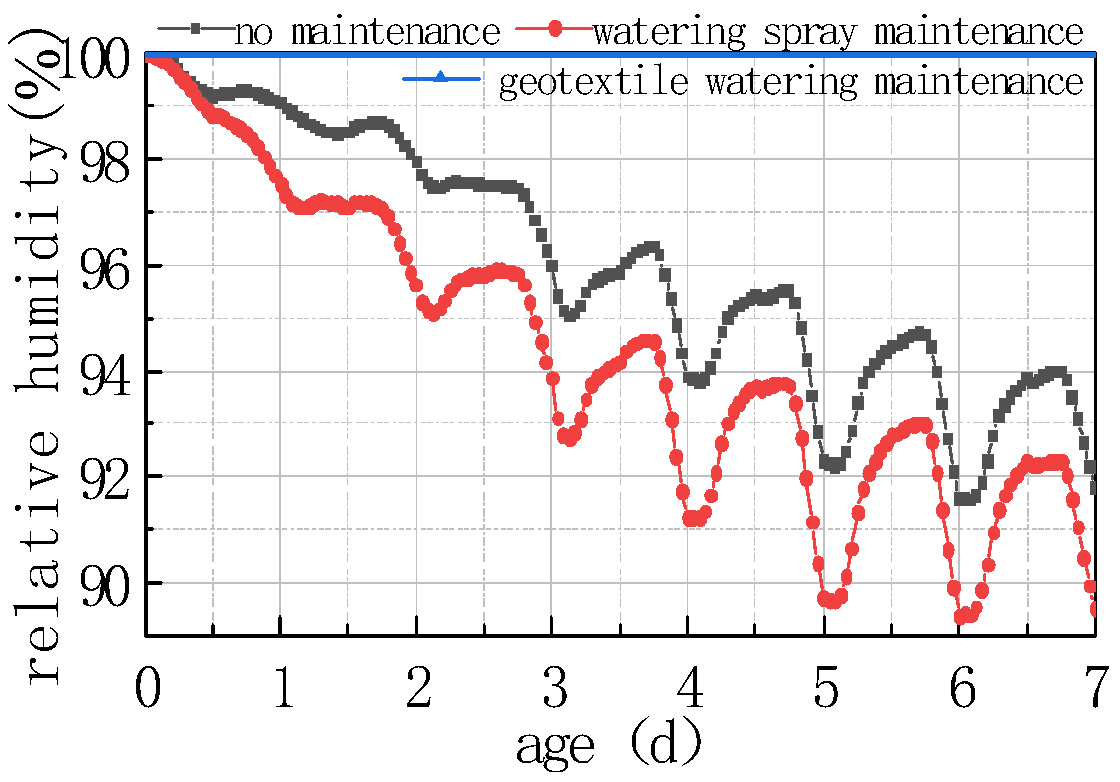
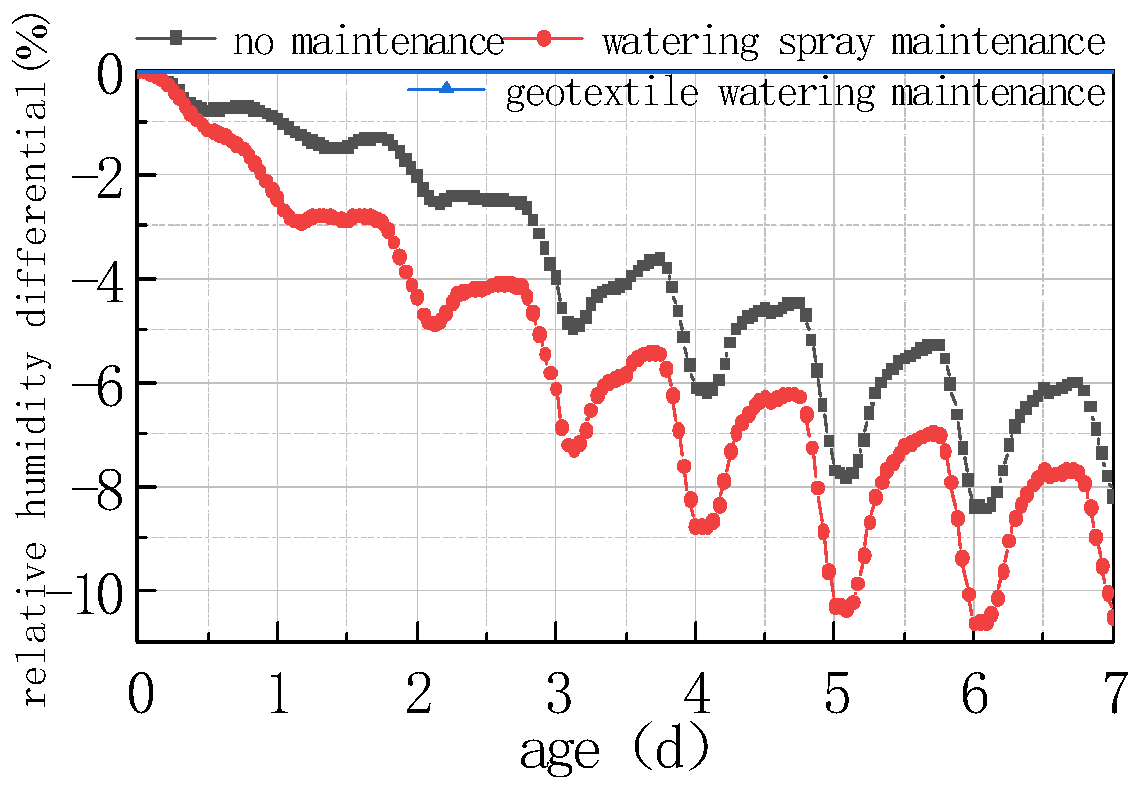
| Variable Type | Name of Parameter | Value Range | Reference Value |
|---|---|---|---|
| Mixture | Cement type/ASTM | Type Ⅰ–Ⅴ | Type I |
| Composition variables | Water–cement ratio | 0.38~0.42 | 0.40 |
| Environmental parameters | Daily average temperature/°C | Meteorological and weather measurements for Xiamen in January, April, July, and October | July |
| Daily average humidity/°C | |||
| Environmental humidity/% | |||
| Daily average windspeed/m/s | 0~6 | 3 | |
| Daily maximum solar radiation intensity/w/m2 | 0~1200 | 600 | |
| Sunlight duration/h | 12 | ||
| Construction parameters | Thickness of pavement slab/cm | 28~42 | 38 |
| Paving time/24 h | 0~24 | 12 | |
| Maintenance situation | With/without | Without | |
| Parameter Situation | Working Condition Value | Reference Condition | Relative Humidity of the Slab/% | Humidity Difference between the Bottom and the Top of the Slab/% | ||||
|---|---|---|---|---|---|---|---|---|
| Peak Value/% | The Difference with Reference Value /% | Sensitivity Level | Peak Value/% | The Difference with Reference Value/% | Sensitivity Level | |||
| Cement type | Type II | Type I | 91.51 | −0.05 | Low | 8.49 | 0.05 | Low |
| Type III | 91.54 | −0.02 | 8.46 | 0.02 | ||||
| Type IV | 91.54 | −0.02 | 8.46 | 0.02 | ||||
| Type V | 91.55 | −0.01 | 8.45 | 0.01 | ||||
| Water–cement ratio | 0.33 | 0.38 | 92 | 0.44 | Low | 8 | −0.44 | Low |
| 0.41 | 91.59 | 0.03 | 8.41 | −0.03 | ||||
| 0.45 | 91.43 | −0.13 | 8.58 | 0.14 | ||||
| Environmental humidity | January | July | 94.33 | 2.77 | High | 5.61 | −2.83 | High |
| April | 91.89 | 0.33 | 7.63 | −0.81 | ||||
| October | 88.13 | −3.43 | 11.5 | 3.06 | ||||
| Windspeed | 0 m/s | 2 m/s | 92.22 | 0.91 | Middle | 7.78 | −0.91 | Middle |
| 4 m/s | 90.45 | −0.86 | 9.55 | 0.86 | ||||
| 6 m/s | 89.6 | −1.71 | 10.4 | 1.71 | ||||
| Solar radiation | 300 W/m2 | 600 W/m2 | 91.9 | 0.26 | Low | 8.11 | −0.26 | Low |
| 900 W/m2 | 91.44 | −0.2 | 8.56 | 0.19 | ||||
| 1200 W/m2 | 91.3 | −0.34 | 8.7 | 0.33 | ||||
| Slab thickness | 0.2 m | 0.42 m | 91.52 | −0.04 | Low | 8.48 | 0.04 | Low |
| 0.28 m | 91.54 | −0.02 | 8.46 | 0.02 | ||||
| 0.38 m | 91.55 | −0.01 | 8.45 | 0.01 | ||||
| 0.48 m | 91.56 | 0 | 8.44 | 0 | ||||
| Paving time | 0:00 h | 13 h | 91.55 | −0.01 | Low | 8.45 | 0.01 | Low |
| 6:00 h | 91.46 | −0.1 | 8.54 | 0.1 | ||||
| 18:00 h | 91.41 | −0.15 | 8.59 | 0.15 | ||||
| Maintenance method | Watering | None | 89.39 | −2.17 | High | 10.61 | 2.17 | High |
| Geotextile + watering | 100 | 8.44 | 0 | −8.44 | ||||
Disclaimer/Publisher’s Note: The statements, opinions and data contained in all publications are solely those of the individual author(s) and contributor(s) and not of MDPI and/or the editor(s). MDPI and/or the editor(s) disclaim responsibility for any injury to people or property resulting from any ideas, methods, instructions or products referred to in the content. |
© 2023 by the authors. Licensee MDPI, Basel, Switzerland. This article is an open access article distributed under the terms and conditions of the Creative Commons Attribution (CC BY) license (https://creativecommons.org/licenses/by/4.0/).
Share and Cite
Chai, M.; Hu, C.; Wang, L.; Chen, T. Study on the Evolution Behavior of Humidity Fields in Cement Concrete Pavements of a Coastal Airport During Early Stages in Humid and Hot Areas. Materials 2023, 16, 5643. https://doi.org/10.3390/ma16165643
Chai M, Hu C, Wang L, Chen T. Study on the Evolution Behavior of Humidity Fields in Cement Concrete Pavements of a Coastal Airport During Early Stages in Humid and Hot Areas. Materials. 2023; 16(16):5643. https://doi.org/10.3390/ma16165643
Chicago/Turabian StyleChai, Min, Changbin Hu, Lijuan Wang, and Tao Chen. 2023. "Study on the Evolution Behavior of Humidity Fields in Cement Concrete Pavements of a Coastal Airport During Early Stages in Humid and Hot Areas" Materials 16, no. 16: 5643. https://doi.org/10.3390/ma16165643
APA StyleChai, M., Hu, C., Wang, L., & Chen, T. (2023). Study on the Evolution Behavior of Humidity Fields in Cement Concrete Pavements of a Coastal Airport During Early Stages in Humid and Hot Areas. Materials, 16(16), 5643. https://doi.org/10.3390/ma16165643





